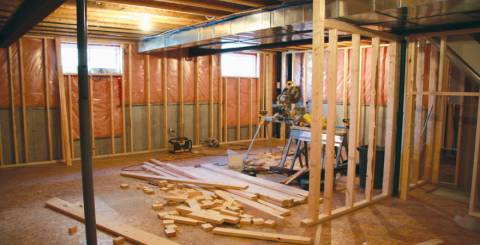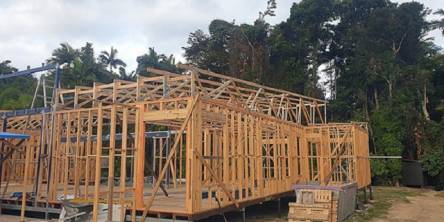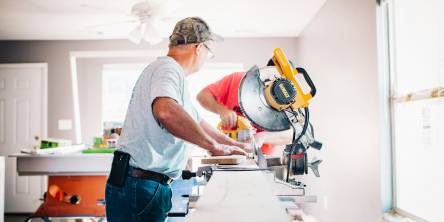Preparing Your Basement for a Remodel

It’s easy to envision all the decorative possibilities for your basement, especially if it is a relatively bare space that isn’t utilized for much more than overflow item storage. Whether you see a spare bathroom or a fully furnished sports cave for your basement, it’s important to not fall so deeply in love with your vision that you overlook key, pre-remodel preparations.
Most basements are built with a few specific functions in mind, namely to house your HVAC installations and route crucial lighting, plumbing and ventilation schemes. As such, those that designed and constructed your basement’s floor plan likely didn’t have your basement finishing dreams in mind. Before you start creating your basement amenity wish list, it’s important to identify your space’s vulnerabilities and address them on a foundational level.
To give you a better idea of the specific areas of your basement to target, here’s a list of pre-remodel preparation tips to consider:
Inspect Basement Walls for Moisture Damage
This should be item one on your preparation list because underlying water damage can create a host of long-term structural concerns. You wouldn’t build a home on a faulty foundation—and the same logic is at play when it comes to your basement. Closely inspect your basement walls for telltale signs like water stains, discoloration, leakages, and stagnant water pooling.
If you see any of these, it’s advisable to reach out to a contractor that can get behind your walls and inspect the state of your plumbing. While this would be an unfortunate setback at the outset of your basement remodel, it does present an excellent opportunity to compare your current plumbing and lighting schemes to your ideal floor plan. If the two don’t sync up, you could reconfigure them to maximize living space and give yourself more freedom when arranging your new basement’s layout.
Procure All Necessary Building Permits
Depending on where you live and your home’s history or construction, it might be necessary to apply for specific building permits to adhere to various residential code regulations. This is especially important if, as alluded to above, you need preliminary plumbing or electrical work down before installing any framing or drywall.
Identify Any Unsafe Construction Materials
If you live in a contemporary home, this may be less of a concern, but it’s always good to confirm with a remodeling contractor or home inspector. Home construction practices have changed greatly over the last half-century. Hazardous materials were commonly used when building homes that predate the 80s. Despite being widely recognized as unsafe material that causes serious respiratory issues, asbestos was commonly employed when sealing ductwork. Also, homes built prior to 1978 were often covered in a base coat of lead paint. If your home was built with these or other hazardous construction materials, it’s best to address these issues before continuing your basement remodel.
Create Unobstructed Exits
Every room in your home should have established exit points—and your basement is no different. Since basements often only have one entry and exit, many homeowners opt to create additional ones by installing windows in their underground space. Not only does this maximize the safety of the area; it also brings in more natural light and makes your basement look even more habitable. It’s important to note, though, that any windows you install should be large enough for a grown adult to climb through in the event of an emergency.
Don’t Crowd Your HVAC Equipment
Home remodeling evokes images of complete room transformations, and while you have more decorative freedom with rooms resting above ground, there are some areas of your basement that must remain untouched for safety purposes. Water heaters, furnaces, and ventilation systems, to name a few, have respective spacing requirements to ensure safe operation, so while these areas may look bare and present an unintended break in your ideal design scheme, it’s important to prioritize security and remove all nearby furniture, fixtures, and general clutter. If you do find there's an especially high amount of clutter in the basement, then try hiring a dumpster from Waste Removal USA. All of the details about sizing and location are available to read on their website, and you'll be able to dispose of the building material and junk at the same time too.
Install Vapor Barriers for Added Moisture Protection
Before you begin fastening frames and installing drywall, make a note to line your unfinished basement walls with a vapor barrier as a last line of defense against moisture permeation. Vapor guards are available as a standalone product, but certain types of insulation are fabricated with vapor guard layers for an all-encompassing solution. As an alternative, you can also apply spray foam insulation for an added degree of protection.
Use the Correct Fastening Tools
When the time comes to install basement framing, make sure to note your basement wall’s material. If your space resembles most basements, that material will likely be cement, concrete blocks, brick, or metal. In that case, using conventional screws and nails won’t give you the secure fastening strength you need.
Basement renovation experts often employ a powder-accentuated fastener, commonly referred to as a shotgun fastener, to dispatch a high-velocity charge that lodges anchor points deep within the foundational walls. These fasteners are readily available for purchase, but if you’ve never operated one, it may be preferable to work with basement remodeling experts that have.
Safe Precautions Make for a Satisfying, Long-Lasting Basement Remodel
Soon, your basement will achieve its destiny—whether that means being transformed into the immersive home theater you’ve always wanted, or becoming the rightful shrine that your life-long sports team deserves. Before it does, though, make sure to complete these vital inspections and pre-remodel preparations to ensure that your newly finished basement is an eye-grabbing showpiece for years to come!
Similar Articles
AS 1684 is vital for ensuring the safety, stability, and compliance of timber-framed buildings in Australia. However, many professionals make mistakes when applying this standard, which can compromise the quality and integrity of a project.
When people think about insulation, they often associate it with keeping homes warm in the winter and cool in the summer. While temperature regulation is one of its primary functions, insulation offers a range of additional benefits that many homeowners overlook
Boost home energy efficiency with top renovation tips—insulation, smart appliances, HVAC upgrades & more. Save money & reduce environmental impact!
Have you ever looked up at your roof and wondered if it’s still in tip-top shape? Are you asking yourself whether those small cracks or worn-out tiles could lead to bigger problems down the line? If so, you’ve come to the right place.
Smart home remodel tips: splurge on countertops & flooring, save on decor & lighting. Balance budget & luxury for a stylish, functional space!
Discover the rising trend of roller shades in modern homes! Essential window coverings for a sleek, stylish look. Transform your space now!
Transform your outdoor space with stone veneer! Discover benefits, installation tips, maintenance, and creative ideas for enhancing curb appeal and durability.
Marble is a luxury and high-end material that imparts a sense of timelessness to any living space. From a white Carrara marble table to an intricately veined dark marble surface, its elegance and sophistication make it an incredible focal point in your living space.
What do you do with old quilt covers after you’ve used and abused them for several years? Well, for starters, you’ve got to shop for some brand-new king size quilt covers, and then you need to roll your sleeves up for some fun DIY projects









